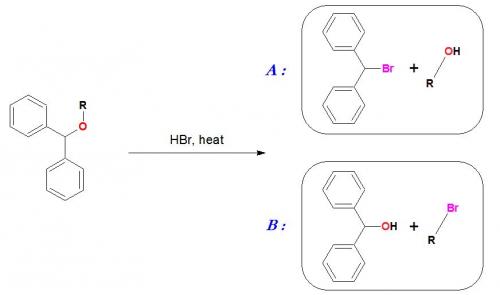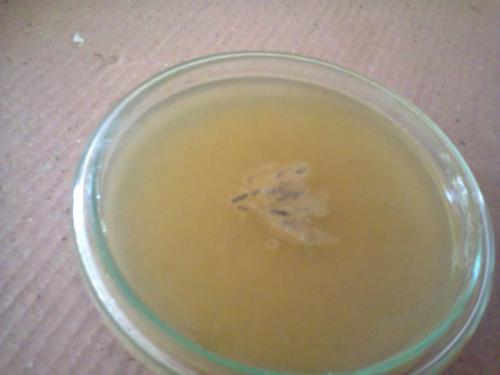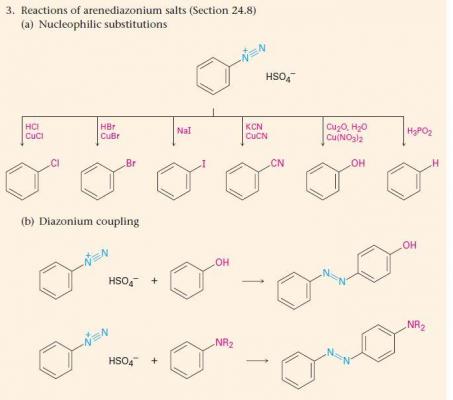-
Posts
20 -
Joined
-
Last visited
About Bromo_DragonFly
- Birthday 01/01/1990
Profile Information
-
Interests
Organic Chemistry
Drug Design
Reading scientific Stuff.
Gardening (My LovelyX Plants)
Organic Chemical Questions
Plant Alkaloid/Oil Extraction
Biological Chemistry -
College Major/Degree
Dummy's MIT !
-
Favorite Area of Science
Organic Chemistry
-
Occupation
underground chemist
Bromo_DragonFly's Achievements

Quark (2/13)
1
Reputation
-
Ok, Just a question rised in my mind after seeing a few videos on ether cleavages using Hbr or HI. the products of the examples given in videos were often phenols, or basically the ether was symmetric. so they don't answer the question for examples like the attached picture. Which of the following will be the results of this cleavage ? A or B ? (or maybe a C where both products are halides.) thanks for any guide .
-

Agar media failing after inoculation ? :(
Bromo_DragonFly replied to Bromo_DragonFly's topic in Microbiology and Immunology
Do you mean if mycelium is utilizing agar, the agar should be liquified ?! have anyone ever encountered this liquidation problem with rowing mycelium ? -

Agar media failing after inoculation ? :(
Bromo_DragonFly replied to Bromo_DragonFly's topic in Microbiology and Immunology
I don't think it's normal, because i have seen many photos from web/books and in none of them i could see a melted/damaged agar media caused by the mycelium growth. and never heard of this watery thing being made by mycelium ! any idea about the reason ? -
Hi all, Two days ago I made my first ever agar media in 4 petri dishes. the recipe I chose to make was V8, which can be found here. the media solidified very well. The problem is, two days after inoculation with Agaricus bisporus spores, the following is happening : a weak mycelium has started to grow around spores. (barely visible) the media around the spores has melted ! a liquidish thing is made in that zones around spores and where the mycelium is visible. the agar media has changed in shape at that zones (dent). and these problems are in all 4 dishes I made. I did the whole process sterile and clean. Any Idea why this happened ? and how to avoid it next time ? and sorry, the attached image can't show the watery thing accumulated in mycelium-grown zone.
-

reducing only one ketone group
Bromo_DragonFly replied to Bromo_DragonFly's topic in Organic Chemistry
the similar stuff i find is for amides. like those reductions done with metal catalysts. but my reaction is not from an amide. how can i get more specific info about enzymatic reactions, their mechanisms .etc ? i mean the ones similar to this kind of reduction. thanks. -
hi friends Q : has any one heard of reducing only one ketone when two are neighbored next to each other ? i want to know if it's possible and whether it has been done before or not. if anyone knows something about it (patents or anything) I'd be thankful to hear about. in fact i want to guess the mechanism for it. I'm asking because it happened in my reaction pot in a yield of around 55%. maybe it's some new stuff. I don't know. I hope it is. picture is what I've done :
-

Chemistry Books for high school students!
Bromo_DragonFly replied to Trekkie_4_Life_69's topic in Chemistry
if you are interested McMurry Organic chemistry book is very helpful on understanding basics to intermediate levels of it. but you actually didn't ask about organic chemistry. if you like chemistry i'm sure you will fall in love with organic part. another one of my favorite : but it's advanced and more organic ! Marchs Advanced Organic Chemistry Reactions, Mechanisms, and Structure Michael B. Smith, Jerry March enjoy reading ! don't forget practicals -
First question : 1 M = 1 Molar = 1mol/liter (note : it means 1 mole of compound per 1 liter of solution. not one liter of solvent.) so you want to make a 0.5 M concentrated solution which means your final solution should contain 0.5Mole of compound (Na2EDTA.2H2O) per each liter of solution. But notice that you need 500ml of solution which is half a liter. So you need 0.25 mole of compound. You should be able to calculate the Molar-Mass for your compound using its molecular formula (Molecular formula of EDTA is C10H16N2O8), so that you can calculate how many grams of it equals 0.25 Mole. Molar -Mass is germ of 1 mole of a compound. EDTA has a molar-mass of 292.24 g/mol. but that's not your exact compound. the compound in your question is Na2EDTA.2H2O which means it's a salt that has absorbed two water molecules to itself. so its Molar-Mass is increased by 36 g/mole by waters, and by 45.98 by sodium atoms.(and remember it has lost two hydrogen atoms to become a salt.) because each water molecule has a molar mass of 18 g/mole. and each sodium atom has molar-mass around 22.99 Molar-Mass of your molecule (Na2EDTA.2H2O) is 372.24 (that's 22.99 + 22.99 + 292.24 + 18 + 18 -1 -1). this means each mole of it weighs 372.24 grams. so to get a quarter of mole you should weigh 93.06 grams of it. (that's 372.24 divided by 4) So your answer is 93.06 grams of Na2EDTA.2H2O is required to make 500ml of 0.5M solution. Extra Info : it seems you have not fully understood the concepts of Molarity and Molality.(or at least the practical part.) so I give you a general info on how to make a solution of 1 M (that's one molar) of a compound. calculate how much compound is required to make that solution. (like how we did above) (this means to know Molar-Mass) weigh the required amount of compound. dissolve it in a less volume of required solvent. (for example in your question you needed to make 500ml, so you should dissolve your compound in something like 200 to 300 ml of water. not 500 at first) add proper volume of solvent to the mixture to get to the desired volume. (it's here that you make your final desired volume, like 500ml in your Question. the reason is : you want the final volume of the solution (which contains both solvent and compound together) to be 500ml) Remember : 1 molal concentration means 1 mole of compound is dissolved in 1 Kg of solvent. So it's different from Molar concentration. ( 1 molal solution is less concentrated than 1 Molar solution,by assuming solvents and compounds be the same.) sorry don't have time for other today, if you're not in a hurry or something wait to see other answers tomorrow. Your questions are basic ones in chemistry so highly recommended to master this concepts. so that you don't have to flash-back your books later.
-

Rare Event Mystery of Exploding Massive Municipal Water Tanks
Bromo_DragonFly replied to ajkoer's topic in Speculations
here in my country (IR) in, they add little amounts of CuSO4 to water storage tanks to kill microorganisms. though it's not fully harm-less, but that's just what they do. there have been reports of people getting sick, and it got found out that CuSO4 could be the reason, but organizations just don't care. and keep adding it without any approval or something. maybe because it's less-costing compound than others. I am NOT saying this is the case in USA or Canada, it's just what is happening here. maybe you can consider it. -

Something bad happened to me
Bromo_DragonFly replied to MohitM's topic in Anatomy, Physiology and Neuroscience
hey my friend. are you sure the numbing is because of those charges? I mean if the numb stays for hours after that static charging happened, then there's a chance it has other reasons. go and visit a doctor and tell him/her that that static charge happened so he can take it into account and have a better idea of what is the best suggestion for you. about EMF or whatever happened on your laptop, it's highly recommended to see a doctor. and don't ask 'what a doctor can do to emf related issue'. it's their job to at least detect the reason for harms, so they can at least assure whether emf is the reason for your mood change or not. as pwagen before me said : "It's always better to be safe than sorry". so truth. by the way, don't think a problem will destroy everything. many things depend on your thoughts and hope. and remember that none of us are the lucky costumers getting ideal stuff from stores. I have had many troubles with my purchases which i can swear all happened because of my bad luck. but never complained about them. because life is too shorter to be spent in sadness or any bad mood. i usually forget them and try to go on without thinking about them. easy. Hope to hear good news from you soon. -
if all hydrogen bonds were unbreakable, then we wouldn't have any Silica Gel Chromatography. I suggest you to read about column chromatography to see how conditions can force a hydrogen bond to establish or break.
-
My guess (only a guess): You can react it with HNO2 + H2SO4 to do a diazotization reaction. you get something like R-----N2+HSO4- which can be substituted by almost any other functional group (like Br) over one or two step. then you can attach your desired stuff to R. I have tried it on many hydrocarbons and it just worked fine. BUT I HAVEN'T TRIED IT ON Lycine OR OTHER AMINO ACIDS. Source to read more if you want : McMurry Organic Chemistry 8th edition.
-

How Can I Learn Chemisty To Get Ready For College?
Bromo_DragonFly replied to Lilone329's topic in Chemistry
here's what you'll enjoy and learn basics from : Fundamentals of Chemistry A book by Romain Elsair if you're really a rookie beginner, there are a few titles to master before getting involved in real thing: 1. compounds naming rules. [you should be able to memorize many Non-Organic compounds names (like 100 at least) and many organic compounds (often used ones) ] you should master it so that you can draw molecule structures by hearing names, without thinking about them. 2. you should have a general idea about material states (gas, liquid, solid), their difference and their effects on reactions. 3. those ordinary general rules of gases, and similar rules you supposed to learn in high-school. 4. Important : reactions and their equations. you should know how to get information from equations. and how to calculate things required, using equations. 5. you should know almost everything about Acids/Bases, their different definitions and reactions of them and so on. 6.The basic route is to learn Non-organic chem first and then go for Organic chem.(there's enough things to learn in Org-Chem to cover your lifetime !) And remember, Studying Chemistry without practical experiments means "Studying Chemistry". you better try to "Learn Chemistry". and avoid being those students who don't know what's the difference between Lab Tubes and Erlenmeyer flask ! -
hey I am the dragonfly myself, although I'm brominated ! wikipedia : http://en.wikipedia.org/wiki/Dragonfly this may become your favorite : http://www.dragonfly-site.com
-
the fact that it dissolves in alot of water but no little water , dosn't assure that it's not some kind of essential oil. but my guess is it's not the result of a fungi/bacterial or other micro-organisms, as many trees bark contain chemicals to prohibit them or at least it wouldn't happen too soon (overnight !!!) you can get a sensible idea of it's chemical formula by reacting it with other known compounds. knowing the solubility isn't enough if you wanna guess it.





